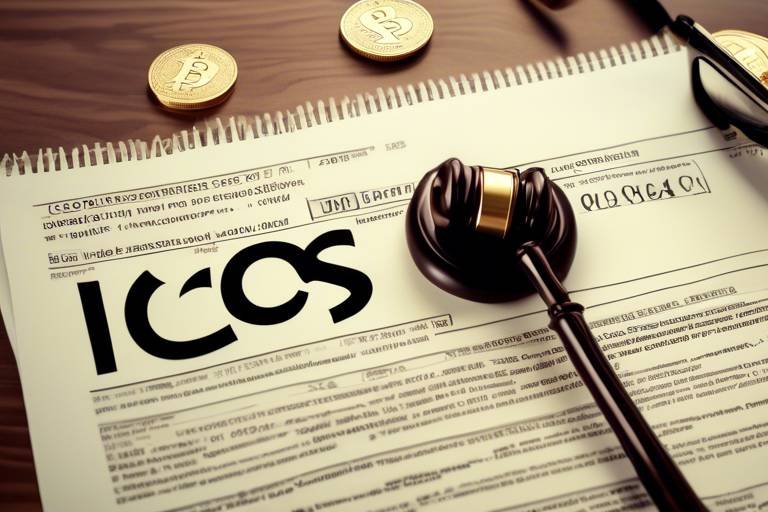How to Manage Regulatory Risks in Crypto Mergers and Acquisitions
In the fast-paced world of cryptocurrency, mergers and acquisitions (M&A) can feel like a thrilling rollercoaster ride. But just like any ride, there are risks involved, particularly when it comes to navigating the complex regulatory landscape. As the crypto industry continues to evolve, so do the regulations that govern it. Therefore, understanding how to manage these regulatory risks is crucial for any organization looking to make a significant move in this space. This article explores effective strategies for navigating the complex regulatory landscape associated with mergers and acquisitions in the cryptocurrency sector, ensuring compliance and minimizing risks throughout the process.
To effectively manage regulatory risks, one must first grasp the various regulatory frameworks that govern cryptocurrency. These frameworks can differ significantly from one jurisdiction to another, making it essential to understand both local and international laws. For instance, while some countries embrace cryptocurrency with open arms, others impose stringent regulations that can stifle innovation. It's like trying to play a game where the rules keep changing; you need to stay updated to avoid penalties and ensure a smooth transaction. The importance of understanding these regulations can't be overstated, as they directly affect the success of M&A activities in this rapidly evolving industry.
As organizations embark on M&A ventures in the crypto sector, they will encounter several regulatory challenges. From compliance and reporting requirements to potential legal pitfalls, it's vital to identify these challenges early on. For example, failing to adhere to local regulations can lead to hefty fines or even the cancellation of the merger. The stakes are high, and the consequences can be severe. Below are some of the primary regulatory challenges that companies should be aware of:
- Compliance with Anti-Money Laundering (AML) Laws: Companies must ensure they are not inadvertently facilitating money laundering through their transactions.
- Reporting Requirements: Organizations often face stringent reporting obligations that can vary by jurisdiction.
- Legal Pitfalls: The potential for legal challenges can arise from misinterpretation of regulations or failure to comply.
Adhering to Anti-Money Laundering (AML) regulations is a cornerstone of managing regulatory risks in crypto M&A. Organizations must take necessary steps to ensure compliance during crypto transactions. This involves implementing robust systems for monitoring transactions and reporting suspicious activities. It's not just about ticking boxes; it's about genuinely safeguarding your organization and the broader financial system. In the eyes of regulators, a failure to comply can result in severe penalties, including fines and restrictions on business operations.
One of the most effective ways to mitigate regulatory risks is through robust Know Your Customer (KYC) procedures. These procedures involve verifying the identities of individuals and entities engaged in transactions. By implementing effective KYC practices, organizations can significantly reduce the risk of being involved in illicit activities. Think of KYC as your organization's first line of defense, ensuring that you know who you are doing business with. Best practices for KYC include:
- Collecting and verifying identification documents.
- Conducting background checks on clients.
- Regularly updating customer information.
Continuous monitoring of transactional activity is crucial in detecting suspicious behavior. Organizations should establish a system that not only tracks transactions but also flags irregularities that could indicate non-compliance. This proactive approach not only ensures adherence to regulatory standards but also enhances overall risk management. By keeping a close eye on the flow of funds and the nature of transactions, companies can quickly identify and address potential issues before they escalate.
Consulting with legal experts who specialize in cryptocurrency regulations is invaluable. These professionals can provide insights into how legal advice can aid in navigating complex M&A processes. They can help you understand the nuances of various regulations and ensure that your organization remains compliant throughout the transaction. Remember, having the right legal support can be the difference between a successful merger and a costly legal battle.
Another critical component of managing regulatory risks is conducting thorough due diligence. This process involves scrutinizing all aspects of a potential merger or acquisition to identify any potential regulatory risks. It’s like peering under the hood of a car before buying it; you want to make sure everything is in working order. Failing to conduct proper due diligence can lead to unforeseen complications down the line, including compliance issues and financial instability.
Understanding the regulatory history of target companies is crucial. Past compliance issues can significantly impact future M&A transactions. If a company has a history of regulatory violations, it may pose a higher risk for the acquiring organization. This is where thorough research pays off; knowing the past can help you make informed decisions and avoid potential pitfalls.
Finally, evaluating the financial stability of the companies involved in a merger or acquisition is essential. This assessment helps in understanding potential regulatory risks and ensuring long-term viability in the crypto market. A financially unstable company can lead to complications that may not only affect the merger but also pose significant regulatory challenges.
- What are the main regulatory challenges in crypto M&A? The main challenges include compliance with AML laws, reporting requirements, and potential legal pitfalls.
- Why is KYC important in crypto transactions? KYC procedures help verify identities, reducing the risk of fraud and regulatory violations.
- How can I ensure compliance during a merger? Engaging legal expertise and conducting thorough due diligence are crucial steps to ensure compliance.

Understanding Regulatory Frameworks
When it comes to the world of cryptocurrency, the regulatory landscape can feel like a maze. Each country has its own set of rules and regulations, and these can vary significantly from one jurisdiction to another. This dynamic environment makes it essential for businesses engaged in mergers and acquisitions (M&A) within the crypto space to have a solid understanding of the regulatory frameworks that govern their operations. Imagine trying to navigate a ship through a storm without a map—without understanding these frameworks, companies risk running aground on legal issues.
At the heart of this regulatory web are several key components, including local laws, international regulations, and industry standards. Local laws can dictate how cryptocurrencies are classified, whether they are seen as securities, commodities, or something entirely different. This classification can have profound implications for how M&A transactions are structured and executed. On the other hand, international regulations often come into play, especially when transactions involve cross-border exchanges or entities. Companies must be aware of regulations such as the Financial Action Task Force (FATF) guidelines, which aim to combat money laundering and terrorist financing globally.
Moreover, understanding the nuances of these regulations is crucial for ensuring compliance. For instance, the European Union's Markets in Crypto-Assets (MiCA) regulation is set to provide a comprehensive framework for the crypto industry, but its implications for M&A activities may not be immediately clear. Companies must stay informed about such developments to avoid potentially costly missteps.
In addition to understanding the regulations, organizations should also be aware of the various regulatory bodies involved. These can range from national financial authorities to international organizations. Each body may have its own approach to regulation, which can lead to inconsistencies and confusion. For example, while some regulators may take a more lenient approach, others may impose strict penalties for non-compliance. Therefore, it is vital for companies to not only understand the regulations but also the regulatory bodies enforcing them.
To sum it up, navigating the regulatory frameworks in the crypto space is akin to walking a tightrope. One misstep can lead to significant consequences, including fines, legal battles, or even the dissolution of a merger or acquisition. Companies must invest time and resources into understanding these frameworks to ensure they are not only compliant but also positioned for success in an ever-evolving industry.

Identifying Key Regulatory Challenges
Navigating the world of cryptocurrency mergers and acquisitions can feel like trying to find your way through a dense fog—especially when it comes to understanding the regulatory challenges that lie ahead. As the crypto landscape evolves, so do the rules and regulations that govern it. The complexity of these regulations can be daunting, but identifying the key challenges is the first step toward mitigating potential risks. In this section, we’ll explore some of the most pressing regulatory hurdles that organizations face during crypto M&A transactions, ensuring you’re well-prepared to tackle them head-on.
One of the foremost challenges is compliance with existing laws. Cryptocurrency operates in a unique space that often straddles multiple jurisdictions, making it essential for companies to be aware of local and international regulations. This can include everything from securities laws to tax obligations. For instance, a merger involving a crypto exchange may require compliance with the regulations set forth by the Securities and Exchange Commission (SEC) in the United States, while also adhering to the guidelines established by the Financial Conduct Authority (FCA) in the UK. The overlapping nature of these regulations can lead to confusion, and failure to comply can result in hefty fines or even the dissolution of the merger.
Another significant challenge is the reporting requirements that come with crypto transactions. Unlike traditional mergers, where financial disclosures can be somewhat standardized, crypto transactions often require a more nuanced approach. Companies must be prepared to provide detailed reports on their financial activities, including the sources of funds, transaction histories, and any potential risks associated with the assets being acquired. This level of transparency is crucial for regulatory bodies, but it can also add layers of complexity to the M&A process.
Moreover, the potential for legal pitfalls is ever-present in the crypto world. With regulations still evolving, companies may find themselves on shaky legal ground if they’re not up-to-date with the latest changes. For example, a company that merges with another that has a history of regulatory violations may inadvertently inherit those issues, leading to complications down the road. The importance of conducting thorough due diligence cannot be overstated here; understanding the legal landscape of both parties involved is crucial to avoid future headaches.
In addition to these challenges, there’s also the growing concern around fraud and cybersecurity risks. The decentralized nature of cryptocurrencies makes them attractive to bad actors, and any merger or acquisition involving crypto assets must take these risks into account. Companies need to implement robust security protocols to protect against potential breaches that could compromise sensitive data or lead to financial losses. This involves not only technological solutions but also a cultural shift within the organization to prioritize security at every level.
To summarize, the regulatory landscape of cryptocurrency mergers and acquisitions is riddled with challenges that can seem overwhelming at first glance. However, by understanding the key issues—compliance with laws, reporting requirements, potential legal pitfalls, and cybersecurity risks—companies can better navigate this complex terrain. Staying informed and proactive is crucial, as the crypto world continues to evolve at a breakneck pace.
- What are the main regulatory bodies overseeing cryptocurrency? Various regulatory bodies exist globally, including the SEC in the U.S., the FCA in the U.K., and the European Securities and Markets Authority (ESMA) in Europe.
- How can companies ensure compliance during M&A transactions? Companies should conduct thorough due diligence, engage legal experts, and implement robust compliance programs to navigate regulatory requirements effectively.
- What are the consequences of failing to comply with crypto regulations? Non-compliance can lead to significant penalties, legal action, and reputational damage, which can severely impact the success of the merger or acquisition.

Compliance with Anti-Money Laundering (AML) Laws
In the fast-paced world of cryptocurrency, is not just a regulatory checkbox—it's a critical aspect of ensuring the legitimacy and sustainability of any merger or acquisition. As organizations dive into the crypto space, they must recognize that the legal landscape is as dynamic as the technology itself. This means that understanding and adhering to AML regulations is paramount to avoiding legal pitfalls that could derail a transaction.
AML laws are designed to prevent illicit activities, such as money laundering and terrorist financing, which can be particularly challenging in the decentralized world of cryptocurrencies. Therefore, companies involved in mergers and acquisitions must implement robust AML programs that not only comply with local regulations but also align with international standards. This involves a series of proactive measures that organizations should take:
- Risk Assessment: Conduct a thorough risk assessment to identify potential vulnerabilities within the organization and its operations.
- Policy Development: Develop and enforce AML policies that are tailored to the specific risks associated with cryptocurrency transactions.
- Training and Awareness: Provide ongoing training for employees to recognize suspicious activities and understand regulatory requirements.
By taking these steps, organizations can create a culture of compliance that not only meets regulatory expectations but also builds trust with stakeholders. Furthermore, it’s essential to keep abreast of the ever-changing AML regulations across different jurisdictions, as non-compliance can lead to severe penalties and reputational damage.
Moreover, the role of technology in AML compliance cannot be overstated. With the advent of advanced analytics and machine learning, companies can enhance their ability to monitor transactions in real-time, flagging any anomalies that may indicate money laundering activities. This technological edge is crucial, especially in a sector where transactions can occur at lightning speed.
In summary, compliance with AML laws is not merely a regulatory obligation; it’s a fundamental component of a successful crypto merger or acquisition strategy. By prioritizing AML compliance, organizations can mitigate risks, enhance their reputations, and ultimately drive sustainable growth in the ever-evolving cryptocurrency landscape.

Implementing Effective KYC Procedures
In the rapidly evolving world of cryptocurrency, implementing effective Know Your Customer (KYC) procedures is not just a regulatory checkbox; it’s a vital shield against potential risks. Think of KYC as your digital bouncer, ensuring that only legitimate customers are allowed into your crypto club. By verifying the identities of your users, you not only comply with regulations but also foster trust in your platform. So, how can organizations effectively implement KYC procedures? Let’s break it down.
First and foremost, organizations must establish a comprehensive KYC policy that outlines the necessary steps for customer verification. This policy should include various methods for identity verification, such as:
- Government-issued identification (e.g., passports, driver’s licenses)
- Proof of address (e.g., utility bills, bank statements)
- Biometric verification (e.g., facial recognition, fingerprints)
By employing a multi-faceted approach to identity verification, companies can significantly reduce the risk of onboarding fraudulent users. Additionally, it’s essential to keep in mind that the KYC process should be user-friendly. Nobody likes a cumbersome sign-up process, right? Streamlining the KYC experience can enhance customer satisfaction while still ensuring robust compliance.
Moreover, continuous monitoring is a key aspect of effective KYC implementation. This means that organizations should not only verify customers at the onboarding stage but also regularly review their transactions and activities. By keeping an eye on user behavior, companies can quickly identify any suspicious activity that may indicate money laundering or fraud. For instance, if a customer suddenly makes a series of high-value transactions that deviate from their typical behavior, this could raise a red flag.
Another critical element to consider is the importance of training staff on KYC procedures. Your team should be well-versed in the regulatory requirements and equipped to handle any KYC-related inquiries. Regular training sessions can help keep everyone up-to-date with the latest regulations and best practices, ensuring that your organization remains compliant and minimizes risks.
Lastly, leveraging technology can greatly enhance KYC processes. Automated KYC solutions can streamline verification and monitoring, reducing the burden on your team while increasing efficiency. These technologies can analyze vast amounts of data in real-time, identifying patterns and flagging anomalies that might go unnoticed by human eyes.
In conclusion, implementing effective KYC procedures is a cornerstone of managing regulatory risks in the cryptocurrency sector. By establishing robust verification processes, continuously monitoring user activity, training staff, and leveraging technology, organizations can create a safer environment for their customers while ensuring compliance with regulatory standards.
Q1: What is KYC in cryptocurrency?
KYC, or Know Your Customer, is a process used by cryptocurrency exchanges and other financial institutions to verify the identity of their customers. This helps prevent fraud and ensures compliance with regulatory requirements.
Q2: Why is KYC important?
KYC is crucial for preventing money laundering, fraud, and other illicit activities. It helps organizations identify and mitigate risks associated with their customer base, fostering trust and compliance.
Q3: How can technology improve KYC processes?
Technology can automate and streamline KYC procedures, making the verification process faster and more efficient. Automated systems can analyze large datasets to identify suspicious activities and ensure compliance with regulations.
Q4: What are the consequences of not implementing KYC?
Failing to implement KYC can lead to severe legal consequences, including hefty fines and penalties. Additionally, it can damage an organization’s reputation and erode customer trust.

Monitoring Transactional Activity
In the fast-paced world of cryptocurrency, is not just a good practice; it’s an essential component of effective regulatory compliance. Just like a hawk watches its surroundings, organizations must keep a vigilant eye on every transaction that occurs within their ecosystem. This proactive approach helps in identifying suspicious behavior that could lead to potential legal issues down the line. But what does this monitoring entail, and how can companies ensure they are doing it effectively?
First and foremost, organizations need to establish a robust monitoring system that can track all transactions in real-time. This system should be equipped with advanced analytics and machine learning capabilities to detect patterns that might indicate illicit activities, such as money laundering or fraud. Imagine trying to find a needle in a haystack—without the right tools, it’s nearly impossible. Similarly, without sophisticated monitoring systems, it’s challenging to spot transactions that deviate from the norm.
Furthermore, it’s crucial to implement a risk-based approach to monitoring. This means categorizing transactions based on their risk levels. For example, high-value transactions or those involving new customers may warrant closer scrutiny compared to regular transactions. By focusing resources where they are most needed, organizations can enhance their compliance efforts while also optimizing operational efficiency. Consider this a strategy where you allocate your attention to the most pressing concerns, much like prioritizing urgent tasks on a to-do list.
Another vital aspect of monitoring is maintaining detailed records of all transactions. Not only does this practice help in complying with regulatory requirements, but it also provides a valuable audit trail in case of any disputes or investigations. Keeping meticulous records is akin to having a well-organized filing cabinet; when you need to retrieve information, everything is at your fingertips. This transparency not only builds trust with regulators but also enhances the credibility of the organization in the eyes of its stakeholders.
Moreover, organizations should regularly review and update their monitoring processes. The regulatory landscape is constantly evolving, and so are the tactics employed by those looking to exploit weaknesses in the system. By staying ahead of the curve and adapting to new regulatory requirements, companies can mitigate risks effectively. This continuous improvement process is similar to tuning a musical instrument; regular adjustments ensure that everything stays in harmony.
In conclusion, monitoring transactional activity is a multifaceted endeavor that requires a blend of technology, strategy, and diligence. By investing in the right systems, adopting a risk-based approach, maintaining thorough records, and continuously refining processes, organizations can not only comply with regulatory standards but also foster a culture of integrity and trust. After all, in the world of cryptocurrency, where the stakes are high and the landscape is ever-changing, staying vigilant is not just an option—it’s a necessity.
- Why is monitoring transactional activity important in crypto?
Monitoring helps identify suspicious activities that could lead to legal issues and ensures compliance with regulatory standards. - What tools can be used for monitoring?
Advanced analytics and machine learning tools can help detect patterns and anomalies in transactional data. - How often should monitoring processes be reviewed?
Organizations should regularly review and update their monitoring processes to adapt to the evolving regulatory landscape. - What is a risk-based approach to monitoring?
A risk-based approach categorizes transactions based on their risk levels, allowing organizations to focus their resources effectively.

Engaging Legal Expertise
When it comes to navigating the intricate world of cryptocurrency mergers and acquisitions, engaging legal expertise is not just a good idea; it's a necessity. The regulatory landscape surrounding crypto is constantly evolving, and the implications of getting it wrong can be dire. Imagine embarking on a journey without a map—it's risky and could lead you into uncharted territory. That's why having a legal expert who specializes in cryptocurrency regulations is crucial for any organization looking to make a move in this space.
Legal professionals who are well-versed in the nuances of cryptocurrency can provide invaluable insights that can help mitigate risks. They understand the complexities of compliance and can guide you through the labyrinth of laws that govern digital assets. For instance, they can help you interpret local regulations versus international standards, ensuring that your M&A activities are compliant across the board. This is particularly important because different countries have different approaches to crypto regulation, which can complicate cross-border transactions.
Moreover, legal experts can assist in drafting and reviewing agreements to ensure that all terms are clearly defined and that potential liabilities are addressed. They can also provide advice on how to structure the deal in a way that minimizes regulatory scrutiny. Think of them as your legal GPS, recalibrating your route whenever you veer off course, ensuring you reach your destination without unnecessary detours.
In addition to compliance and contract drafting, engaging legal expertise can also help you navigate potential disputes that may arise during the M&A process. Disagreements over contract terms, valuation, or even regulatory interpretations can lead to costly legal battles. By having a legal expert on your side, you can proactively address these issues before they escalate. They can also represent your interests in negotiations, providing you with the leverage needed to secure favorable terms.
In summary, engaging legal expertise is not merely an option; it’s a strategic move that can safeguard your organization against regulatory pitfalls. By leveraging their knowledge and experience, you can navigate the complexities of crypto mergers and acquisitions with confidence, ensuring that you are not only compliant but also positioned for success in this dynamic market.
- Why is legal expertise important in crypto M&A? Legal experts help navigate the complex regulatory landscape, ensuring compliance and minimizing risks.
- What are the risks of not engaging legal counsel? Without legal counsel, organizations may face compliance issues, costly disputes, and potential legal penalties.
- How can legal experts assist in due diligence? They can evaluate the regulatory history and compliance status of target companies, identifying potential risks before transactions are finalized.
- What should I look for in a legal expert for crypto M&A? Look for someone with specific experience in cryptocurrency regulations and a proven track record in M&A transactions.

Conducting Thorough Due Diligence
In the fast-paced world of cryptocurrency mergers and acquisitions, conducting thorough due diligence is not just a box to check; it’s a critical step that can mean the difference between success and failure. Imagine you’re buying a used car. Would you simply take the seller’s word for it, or would you want to inspect the vehicle, check its history, and ensure it’s roadworthy? The same principle applies to M&A in the crypto space. Here, due diligence serves as your inspection, helping you uncover potential regulatory risks that could derail your plans.
First and foremost, it’s essential to evaluate the regulatory history of the target companies. Understanding their compliance track record can give you invaluable insights. If a company has faced legal challenges or regulatory fines in the past, it’s a red flag. You wouldn’t want to inherit a headache, would you? This history can also influence how regulators view the merger or acquisition, potentially complicating the approval process. Therefore, reviewing documents such as past compliance reports and any correspondence with regulatory bodies is crucial.
Moreover, assessing the financial stability of the companies involved is another vital aspect of due diligence. A financially unstable company can pose significant risks, not just from a regulatory standpoint but also from a business perspective. For instance, if a target company is heavily in debt or has inconsistent revenue streams, it could struggle to meet regulatory requirements, leading to potential fines or even the revocation of licenses. To get a clearer picture, consider analyzing financial statements, cash flow reports, and any outstanding obligations. This assessment helps in ensuring that the companies involved are not only compliant but also capable of sustaining their operations in the long run.
Additionally, it’s wise to create a comprehensive due diligence checklist that encompasses various aspects of both companies. Here’s a simple example of what such a checklist might look like:
| Due Diligence Area | Key Questions |
|---|---|
| Regulatory History | Has the company faced any regulatory actions? What were the outcomes? |
| Financial Stability | What do the financial statements indicate about the company’s health? |
| Compliance Procedures | What AML and KYC procedures are currently in place? |
| Market Position | How does the company rank within its sector? |
By following a structured approach to due diligence, you can minimize risks and make informed decisions. Remember, the goal is not just to check off items on a list but to gain a holistic understanding of the companies involved. This way, you’ll be better equipped to navigate the regulatory landscape and ensure a smoother merger or acquisition process.
- What is due diligence in crypto M&A? Due diligence in crypto M&A involves a thorough investigation of the target company's regulatory history, financial stability, and compliance procedures to identify any potential risks.
- Why is regulatory history important? A company's regulatory history can reveal past compliance issues that may affect future operations and the overall success of the merger or acquisition.
- How can financial stability impact M&A? Financial instability can lead to difficulties in meeting regulatory requirements and pose risks to the merger or acquisition's success.
- What should be included in a due diligence checklist? A due diligence checklist should include areas like regulatory history, financial stability, compliance procedures, and market position.

Evaluating Regulatory History
When diving into the world of mergers and acquisitions in the cryptocurrency sector, one of the most critical aspects to consider is the regulatory history of the target companies. Why is this so important? Well, understanding a company's past interactions with regulatory bodies can provide invaluable insights into potential risks that may arise during the M&A process. Just like a detective sifts through clues to solve a case, evaluating regulatory history helps uncover any red flags that could impact the success of the merger or acquisition.
Regulatory history encompasses various factors, including past compliance issues, legal disputes, and any sanctions imposed by regulatory authorities. For instance, if a target company has faced significant fines or penalties for non-compliance, this could indicate a pattern of behavior that may continue post-acquisition. It's essential to ask: What lessons can we learn from their past? A company that has consistently struggled with compliance might pose a greater risk than one with a clean record.
To effectively evaluate regulatory history, consider the following steps:
- Conduct Comprehensive Research: Utilize multiple sources, such as regulatory filings, news articles, and industry reports, to gather a complete picture of the company's regulatory interactions.
- Analyze Compliance Records: Look into the company's history with compliance—have they faced investigations or sanctions? Understanding the nature and frequency of these issues can help gauge risk levels.
- Consult Legal Experts: Engaging with legal professionals who specialize in cryptocurrency regulations can provide deeper insights into the implications of the company's regulatory history.
Moreover, it's not just about identifying past issues; it's also about understanding how a company has responded to them. A proactive approach to resolving compliance issues can indicate a company’s commitment to regulatory adherence and risk management. For example, if a company faced a significant regulatory challenge but took substantial steps to rectify the situation and improve its compliance framework, this could signal a positive shift in its operational ethos.
Furthermore, evaluating the regulatory history of the target company can also reveal the broader regulatory environment in which it operates. If a company has navigated a particularly strict regulatory landscape successfully, it may have developed robust compliance mechanisms that could be beneficial post-merger. Conversely, if the company has a history of regulatory conflicts in a lenient environment, this could raise concerns about its ability to adapt to a more stringent regulatory framework.
In summary, evaluating the regulatory history of target companies in crypto mergers and acquisitions is not just a box-ticking exercise; it’s a crucial step in mitigating risks and ensuring a smooth transition. By thoroughly understanding a company’s past, you equip yourself with the knowledge needed to make informed decisions that can safeguard your investment and enhance the long-term viability of your new venture.
- Why is regulatory history important in crypto M&A? Understanding regulatory history helps identify potential risks and compliance issues that could affect the success of the merger or acquisition.
- How can I find a company's regulatory history? You can research regulatory filings, news articles, and industry reports, or consult legal experts for deeper insights.
- What should I do if a target company has a troubled regulatory history? Assess the severity of the issues and consider how the company has responded to past challenges. Engaging legal counsel can also provide guidance on the next steps.

Assessing Financial Stability
When diving into the world of mergers and acquisitions in the cryptocurrency sector, one of the most critical factors to consider is the financial stability of the companies involved. Why is this so important, you might ask? Well, just like a shaky foundation can crumble a house, a financially unstable company can jeopardize the entire merger or acquisition process. Assessing financial stability isn't just a box to check off; it's a comprehensive analysis that can save you from potential headaches down the line.
To effectively assess financial stability, it's essential to evaluate several key indicators. These indicators can help paint a clearer picture of a company's overall health and its ability to weather the unpredictable nature of the crypto market. Here are some of the most important factors to consider:
- Revenue Streams: Examine the diversity of revenue sources. Companies with multiple streams are often more resilient to market fluctuations.
- Profit Margins: Analyze profit margins over time. Consistent or growing margins indicate strong financial health.
- Debt Levels: High debt can be a red flag. Understanding a company's debt-to-equity ratio can provide insight into its financial leverage.
- Cash Flow: Positive cash flow is crucial for day-to-day operations. Ensure that the company generates enough cash to meet its obligations.
- Regulatory Compliance History: A company with a history of compliance issues may face financial penalties that can impact its stability.
Moreover, it’s advisable to conduct a comparative analysis with industry peers. This can help gauge whether a company is performing well relative to others in the crypto space. For instance, you could create a simple table comparing key financial metrics across different companies:
| Company Name | Revenue (Last Year) | Profit Margin (%) | Debt-to-Equity Ratio | Cash Flow (Monthly) |
|---|---|---|---|---|
| CryptoCorp | $5M | 20% | 0.5 | $500K |
| BlockChain Inc. | $3M | 15% | 0.8 | $300K |
| TokenTech | $8M | 25% | 0.3 | $700K |
This table illustrates how different companies stack up against one another, providing valuable insights into their financial health. It's crucial to not just look at numbers but to understand the story behind them. Are there any recent changes in management? Have there been any significant investments or losses? All of these factors contribute to the overall financial picture.
In conclusion, assessing financial stability is a multifaceted process that requires careful consideration of various financial indicators and market conditions. By taking the time to thoroughly analyze these elements, you can make informed decisions that minimize regulatory risks and enhance the chances of a successful merger or acquisition in the dynamic world of cryptocurrency.
- What are the key indicators of a company's financial stability? Key indicators include revenue streams, profit margins, debt levels, cash flow, and regulatory compliance history.
- Why is financial stability important in crypto M&A? Financial stability helps ensure that the companies involved can withstand market volatility and regulatory challenges.
- How can I assess a company's financial health? Conduct a thorough analysis of financial statements, compare metrics with industry peers, and consider market trends.
Frequently Asked Questions
- What are the key regulatory frameworks for crypto mergers and acquisitions?
Understanding the regulatory frameworks is crucial for any organization looking to engage in crypto mergers and acquisitions. These frameworks vary by jurisdiction and can include local laws, international regulations, and specific guidelines set by financial authorities. It's essential to stay updated on these regulations to ensure compliance and avoid potential legal issues.
- What are the main regulatory challenges faced during crypto M&A?
During crypto mergers and acquisitions, organizations often face challenges such as compliance with Anti-Money Laundering (AML) laws, meeting reporting requirements, and navigating potential legal pitfalls. These challenges can complicate the M&A process and require thorough planning and expertise to manage effectively.
- How important is compliance with AML laws in crypto transactions?
Compliance with AML laws is vital in crypto transactions, especially during mergers and acquisitions. Organizations must implement robust systems to monitor transactions and ensure they adhere to regulatory standards. This not only mitigates risks but also enhances the credibility of the involved parties in the eyes of regulators and stakeholders.
- What role do KYC procedures play in managing regulatory risks?
Know Your Customer (KYC) procedures are essential for verifying the identities of all parties involved in a transaction. By implementing effective KYC practices, organizations can reduce the risk of fraud and ensure compliance with regulatory requirements, which is particularly important in the fast-evolving crypto landscape.
- Why is engaging legal expertise critical in crypto M&A?
Consulting with legal experts who specialize in cryptocurrency regulations can provide invaluable insights. These professionals help organizations navigate the complex legal landscape, ensuring that all regulatory requirements are met and that potential risks are identified and mitigated before finalizing any merger or acquisition.
- How can due diligence help in identifying regulatory risks?
Conducting thorough due diligence is key to identifying potential regulatory risks before moving forward with a merger or acquisition. This process involves evaluating the regulatory history of target companies, assessing their compliance records, and understanding their financial stability, all of which contribute to informed decision-making.
- What should companies assess regarding the financial stability of M&A targets?
Companies should evaluate the financial stability of potential M&A targets by reviewing their financial statements, understanding their revenue streams, and assessing any existing liabilities. This assessment helps in understanding the potential regulatory risks associated with the merger and ensures that the transaction aligns with long-term viability in the crypto market.



















